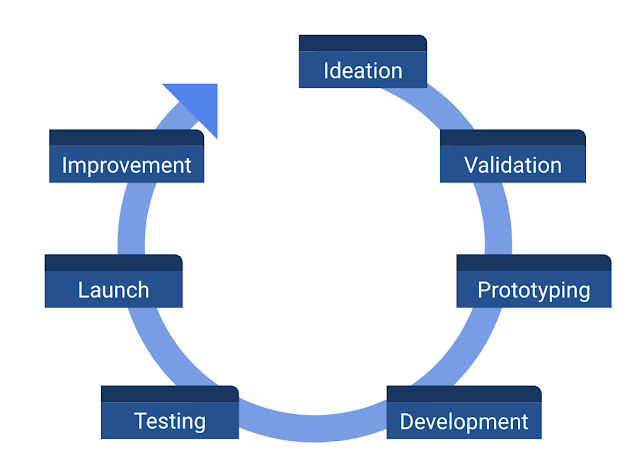What is a Product Development Life Cycle? [Different stages of the Product Development Lifecycle]
Product Development Lifecycle
In the previous article, we discussed Product Lifecycle. While you might think that Product Lifecycle and Product Development Lifecycle are one and the same thing, it's not true. Let's try to find the fundamental differences and understand what Product Development Life Cycle is.
What is a Product Development Life Cycle?
The Product Development Lifecycle is the end-to-end process of taking a product from brainstorming to MVP to final release. Even after the final release, there is a constant improvement done through user feedback.
Let's try to deep dive into the different stages of the Product Development Lifecycle:
 |
| Product Development Lifecycle |
Stage 1: Ideation
During this stage, the team brainstorms different product ideas to determine which of them actually solves users' pain points. Often competitor analysis, market research, etc. are carried out to identify the gaps and understand the opportunities that exist.
Stage 2: Validation
At this stage, Product Managers(PM) start narrowing down the ideas to identify the ones which are feasible. They perform user research through customer calling and surveys to validate the ideas. Talking to the customers helps them understand their needs and wants and how the product that they are building can fulfill the same. A PM should ensure that the survey sample size is statistically significant to avoid any data skew.
Stage 3: Prototyping
Once the idea has been validated, the next step is to build a prototype. The key functions & features are determined based on the inputs received during the validation stage. The Product Design team along with the PM works on low-fidelity wireframes to visualize the product. The designs go through several levels of iterations and user testing which helps in understanding if the user experience needs to be simplified. Finally, high-fidelity wireframes are created to resemble the final design of a project.
Stage 4: Development
Once the prototype has been finalized, it is now the work of the development team[Software developers, Front-end developers, Data engineers, and Designers] to build a minimum viable product(MVP). Here a PM helps the development team by creating a clear product roadmap. The roadmap lays down a long-term timeline with milestones. The PM also ensures that the timelines are being adhered to and addresses any roadblocks.
Stage 5: Testing
After development, it is important to perform a thorough testing of the product. Before committing the final changes, all the edge cases are tested by the developer. Once the feature is live in a test environment, the same is tested by the Quality team. The QA team ensures that the product has been tested to meet both functional & non-functional requirements by testing them through multiple devices, browsers and user flows.
Stage 6: Launch
Once the QA team gives the green light, the product is ready to be launched to the users. A product manager might decide to perform an A/B test and release the product only for a specific set of users. The PM needs to keep a close watch on tracking the product performance by analyzing the complete funnel.
Stage 7: Improvement
Once the product has been launched, there is a constant journey of improving it.
The PM needs to listen and absorb customer feedback carefully. At this stage, they might decide to add new features or improve the existing ones. NPS(Net Promoter Score) surveys are sent to both existing and churned users to understand how the product can be improved.
Major Stakeholders at different stages of the Product Development Lifecycle
Product Manager: We have repeatedly discussed the role of the Product Manager at every stage of the life cycle. A PM oversees the end-to-end process at every stage of the cycle.
Program Manager: Program Manager helps in delegating tasks and coordinating the activities among the different cross-functional stakeholders.
Design: The design team helps in conducting user research through questionnaires. Then they work on prototyping and finalizing the UI/UX of the product.
Development & Testing: The development team comprising backend, frontend, data engineers etc. helps in setting the infrastructure and development of the product. The development & testing team ensures edge cases are being covered.
Sales & Marketing: Depending on the promotional budget, the marketing team launches creative campaigns to attract users. The team helps in carving a go-to-market strategy. They also measure how successful the marketing initiatives are.
There are several tools/frameworks which can help in organizing the Product Development Lifecycle:
Asana helps in managing the entire product development lifecycle and offers seamless collaboration
Design Tools like Figma, Marvel, Adobe XP etc. can be used to create wireframes.
Frameworks like SWOT for competition analysis, SCAMPER for brainstorming etc.
Jira for creating a collaborative roadmap and tracking program

Comments
Post a Comment